Nail Salon Hazards and Precautions for Workers
Working in a glam nail salon may seem like it poses minimal safety risks. However, it’s a profession that involves more hazards than you might realise. All the polishing, gluing, and disinfecting can create chemical fumes that pose a serious risk to your health. Likewise, the way you position your body when working can threaten your physical wellbeing, and you may even face fire and infection risks.
You can easily protect yourself from these hazards by implementing effective control measures around the salon. By following the guidance in this article, you’ll be able to run a salon where workers feel safe and healthy and can focus on polishing customers’ nails to perfection.

Want to Learn More?
Our COSHH Training Course will equip you with the knowledge needed to identify hazardous substances in your workplace and understand the legal requirements of COSHH. You can also take a look at our Infection Prevention & Control (IPC) Training.
Nail Salon Health Risks
The risks you may face in a nail salon are not only significant due to the severity of health problems they can cause. They are also unseen, meaning you could be filing and painting nails day after day without even realising you’re vulnerable. Plus, they affect you gradually over time. This is why safety measures are so vital.
There are three main types of nail salon hazards:
1. Chemical Hazards
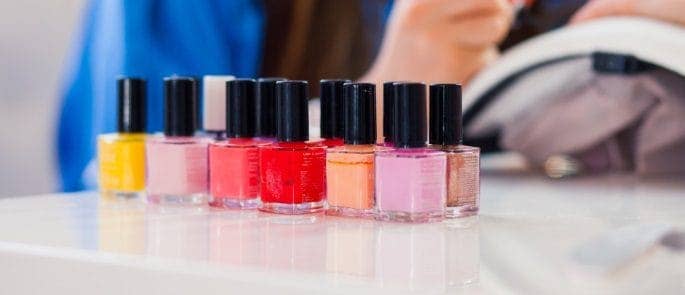
Salon staff constantly work directly with and around hazardous substances:
- Nail polish, artificial nails, primers, fingernail glue, polish remover, and more.
- Filing nails creates dust that can be harmful to inhale.
- Disinfecting chemicals.
- Cloths, cushions, cotton balls, and other fabrics soaked in cleaning chemicals or glue remover.
These hazards pose serious risks to staff’s health and safety:
- Inhalationof chemicals or dust can lead to irritation, headaches, dizziness, sickness, occupational asthma, or even cancer.
- Ingestion can cause throat irritation and illness.
- Direct contact with the skin or eyes can cause irritation, rashes, or occupational eczema and dermatitis.
- Poorly-handled waste chemicals and fabrics continue to spread fumes and pose a fire hazard.
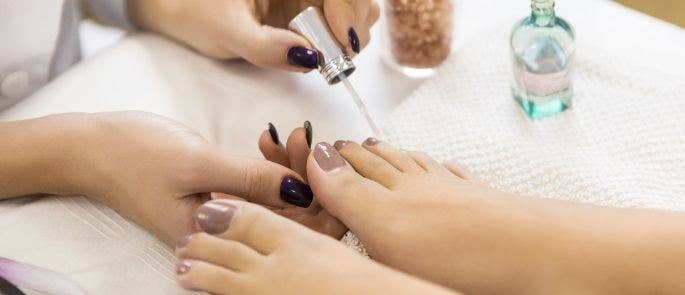
Some of these issues are minor and manageable, like irritations and headaches, while others are debilitating and irreversible, such as occupational asthma or cancer. They can also exacerbate existing health issues, including asthma and eczema.
Don’t make the mistake of thinking these are just ‘hazards that come with the job’. The Control of Substances Hazardous to Health (COSHH) Regulations require all workplaces to protect their staff from harmful substances used for work activities.
2. Ergonomic risks
Many salon workers adopt a poor posture to carry out their job. They may lean over and rest their arms on the desk, which strains their back and applies harmful pressure to contact points on their arms.
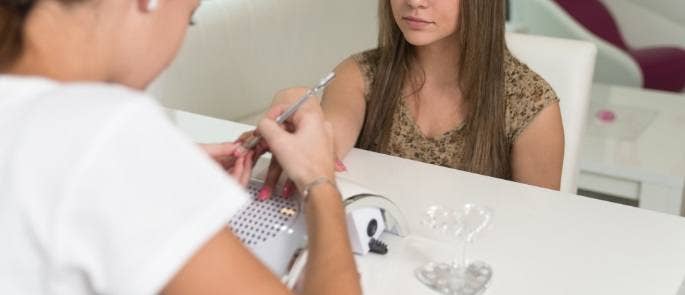
Over time, poor ergonomics can lead to bad joints, sore muscles, and even chronic musculoskeletal disorders.
3. Risk of infection
Customers or staff with broken skin or uncovered wounds may allow infections to spread, particularly when they soak their hands or feet in basins. Good hygiene practices can easily prevent the spread of infection.
How to Control Nail Salon Health Risks
Safety measures for minimising chemical hazards, ergonomic risks, infection risks, and fire hazards are simple to implement and follow. They ensure your nail salon complies with COSHH regulations and keeps everyone safe and in good health.
Safety measures for controlling hazardous chemicals:
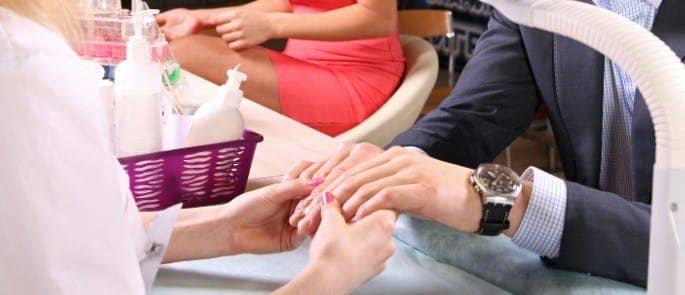
- Know the chemicals you use. You can learn this by reading Material Safety Data Sheets (MSDS), which should accompany all the products in your salon that contain dangerous chemicals. MSDS tell you how to minimise risks for the specific types of chemicals in the products you use.
- Ventilate the work space. Throughout the day, fumes will build up in the room. Use a downdraught table to remove harmful chemicals and open windows to let in more fresh air. If ventilation vents and windows are near each other, make sure staff work away from the window, as this allows fresh air to circulate the room properly.
- Store chemicals safely. Everyone should follow the storage instructions stated by the products they use. They should store them away from heat sources in well-ventilated storage areas, keep bottles closed when they are not using them, and avoid storing more products in the salon than they need.
- Good housekeeping. Staff should clean up chemical spillages right away and do so safely. They must also safely dispose of materials used to clean spillages, as well as cotton balls and other fabrics soaked in chemicals. This type of waste should go in a lined, lidded bin.
- Personal protective equipment. Staff should wear protective gloves to minimise chemical exposure to skin. Nitrile gloves offer the best protection, so avoid latex or vinyl. Note that dust masks are not an acceptable control measure for hazardous chemicals.
- Health surveillance. An occupational health professional should monitor the health of staff who work around chemicals for a significant part of their day.
Controlling chemical hazards will minimise health risks associated with inhalation and physical contact, as well as fire risks.
Safety measures for ergonomic hazards:
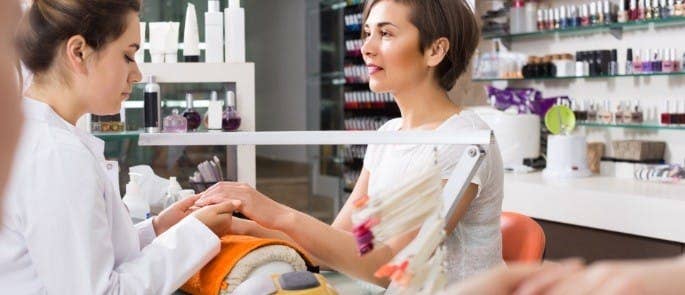
- Staff should sit up straight and keep their arms supported by a cushion or pad on the table.
- They should use an adjustable chair that supports their lower back. Feet should lay flat on the floor without straining the thighs.
- Use a cushion or other means to prop up the customer’s hand or foot to prevent staff from leaning forward.
- Staff should take regular breaks between customers to stretch.
Avoiding musculoskeletal strain is straightforward, so long as staff consistently maintain a good posture and improve their working space.
Safety measures for preventing infections:
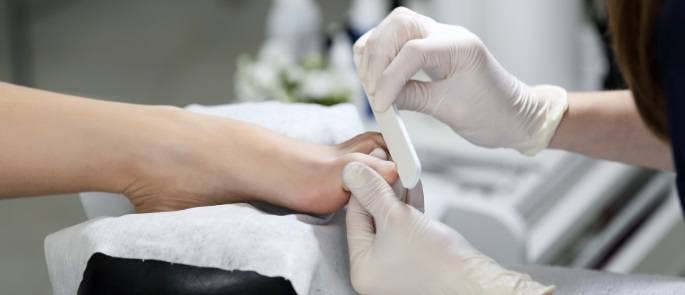
- Staff should wear gloves at all times and dispose of them after each customer.
- Cover wounds with plasters.
- Avoid touching blood or bodily fluids. If staff need to clean these up, they must wear their gloves and dispose of them safely afterwards.
- Thoroughly disinfect tools, worktables, and basins after each customer.
You can easily prevent the spread of infections in your nail salon if you follow these good hygiene practices.
Salon staff who understand the importance of all these safety measures and follow them diligently will keep themselves and customers free from harm.
What to Read Next:
- Hairdressers Guide to COSHH in the Salon
- The New COSHH Hazard Symbols & Their Meanings
- A Guide on Hazards in a Beauty Salon: Free Risk Assessment Template
- How to Safely Store, Handle & Dispose of Corrosive Chemicals
- Online COSHH Training

![]()





